Zoom
Trash

Net.educause.edu/ir/library/pdf/ELI7097.
BYOD. Creativity. Can Any School Foster Pure Creativity?
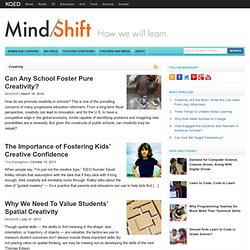
How do we promote creativity in schools? This is one of the prevailing concerns of many progressive education reformers. From a long-term fiscal perspective, creativity can lead to innovation, and for the U.S. to have a competitive edge in the global economy, minds capable of identifying problems and imagining new possibilities are a necessity. But given the constructs of public schools, can creativity truly be valued? Continue Reading The Importance of Fostering Kids’ Creative Confidence When people say, “I’m just not the creative type,” IDEO founder David Kelley refutes that assumption with the idea that if they stick with it long enough, their creativity will inevitably come through.
Continue Reading Why We Need To Value Students’ Spatial Creativity Continue Reading Sir Ken Robinson: How to Escape Education’s Death Valley Continue Reading 10 Ways to Teach Innovation Innovation and the current classroom model most often operate as antagonists. Créer des situations d'apprentissage. La démarche de situation-problème. Exemple de déclinaison d'une situation-problème avec degrés de difficultés En partant de la vie quotidienne Toute situation de vie est susceptible de nous donner des idées de situation-problème, puisqu'elle mobilise nécessairement des savoirs, des savoirs-faire et des savoirs-être.
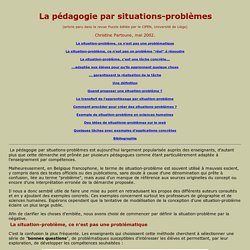
Une publicité, une émission TV, la préparation d'un repas, une ballade en forêt, le choix d'un logement, une carte postale à écrire, un concert, une chanson,... Tout ce que les hommes réalisent depuis qu'ils existent constitue un réservoir de tâches susceptibles de devenir porteuses sur le plan pédagogique ou éducatif. Pensons surtout aux situations de vie que rencontrent les élèves...
A titre d'exemple, nous avons sélectionné une série de tâches-types, déclinées plus particulièrement pour des professeurs de géographie ou de sciences humaines. En partant des objectifs-obstacles 1. Des outils pédagogiques pour les enseignants du primaireFRANÇAIS ÉCRITURE 1er CYCLE. 8 concepts pour une pédagogie ouverte et hybride. Au travers de mes nombreuses lectures sur la pensée et l’apprentissage à l’heure du numérique, 8 concepts semblent revenir :
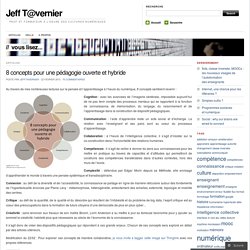
Apprendre à l’ère numérique. Le modèle SAMR : une référence pour l’intégration réellement pédagogique des TIC en classe. Le modèle SAMR offre une méthode permettant de mieux saisir comment la technologie peut avoir un réel impact sur l’enseignement et l’apprentissage.
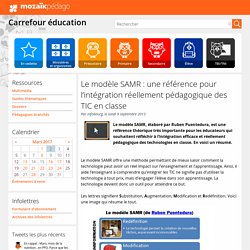
Ainsi, il aide l’enseignant à comprendre qu’intégrer les TIC ne signifie pas d’utiliser la technologie à tout prix, mais d’engager l’élève dans son apprentissage. La technologie devient donc un outil pour atteindre ce but. Les lettres signifient Substitution, Augmentation, Modification et Redéfinition. Voici une image qui résume le tout. Source : Sébastien Stasse. The 8 Digital Skills Students Need for The Future. An outstanding lesson using mobile learning? Recently I was asked / was volunteered to lead something called a "lesson observation for real" in Coventry.

This is essentially a lesson taught in the round in front of anything up to 100 colleagues and, crucially, an OFSTED registered Inspector. The rationale behind it lies not in the inspection of the lesson for a grade, but the sharing of the inspector's thought processes when observing the lesson, and illuminates the (at times unfathomable) thinking behind it all. The EdTech Cheat Sheet for Teachers Infographic.
Educational Technology Infographics Teacher Infographics Trying to understand new educational technology trends with all of the new buzzwords in the booming education technology sector can leave you feel overwhelmed.
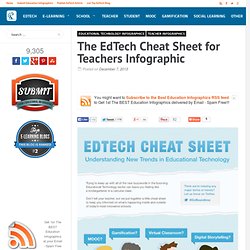
Boundless created this great edtech infographic that I highly encourage you to share it with fellow educators and teachers or even better print it out. In addition, you may want to read the Future eLearning Trends and Technologies in the Global eLearning Industry article. How To Use Free Online Resources In A Flipped Classroom Infographic. Blended Learning Infograpics The using, creating and sharing free online resources in a flipped classroom infographic is based on the results of a survey that the Open Educational Resources Research Hub (OERRHub) conducted to find out how flipped educators are using and thinking about open educational resources.

I highly encourage you to read the article Using, creating and sharing free online resources in a flipped classroom. Did You Know? Flickr CC Attribution Helper. Did you know that there WAS a Google Chrome Extension that helped you give proper attribution to images on Flickr?

Well, there was and it was called Flickr CC Attribution Helper ... and it was awesome! Unfortunately, the most recent update on Flickr does not allow for this chrome extension to work properly. How to Add Questions for Students to YouTube Videos. With the popularity of flipped classrooms showing no sign of waning, a new crop of web tools for teachers are emerging to help support instruction.

In this post, I take a look at four ways that teachers can add questions to a YouTube video for their students to answer when watching a video at home or on their own. 1. Educanon.com For a more polished approach, check out Educanon.com. It works with YouTube, Vimeo or TeacherTube videos. To get started, simply copy and paste the link to the video into the Educanon video builder. 2. The last site I am going to share is called EDpuzzle. Why I am Flipping My Classroom. I have decided to flip my Technology for Teachers TEDU 480 course this next semester.

Why? Is it just to follow the trend, to say I am flipping my class, or to try something new? Honestly, it is none of them. Teacher to Teacher: 7 Steps for Integrating Technology - Getting Smart by Aimee Bartis - edchat, EdTech, educlipper, GAFE, Google Apps for Education, ntchat, Pathbrite, portfolio, Today's Meet. You’ve attend district and campus staff development. You understand some of what the district’s chosen device can do. It’s time to get started. 1. Perfectionism and Control When using technology, perfectionism is out the door. If something can go wrong, it will. 2. 3. 4. 5. 6. 7. Integrating technology is an ongoing project. For more on tech integration see the Blended Learning Implementation Guide; for more on portfolios, see: